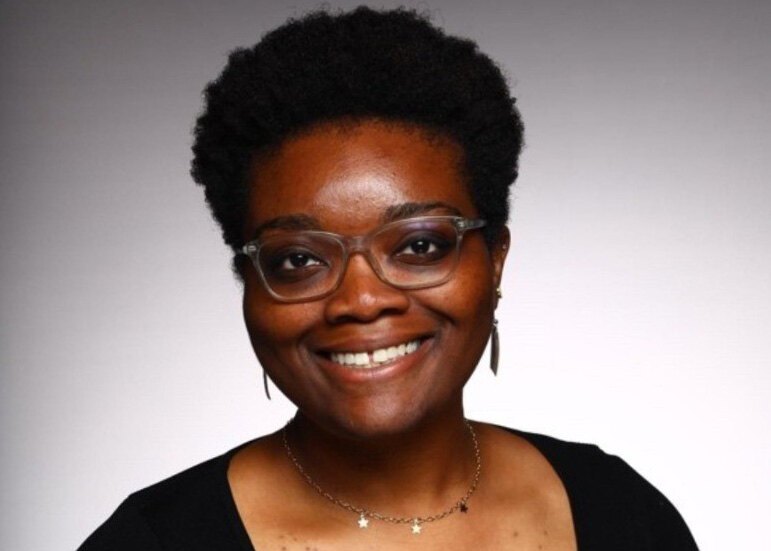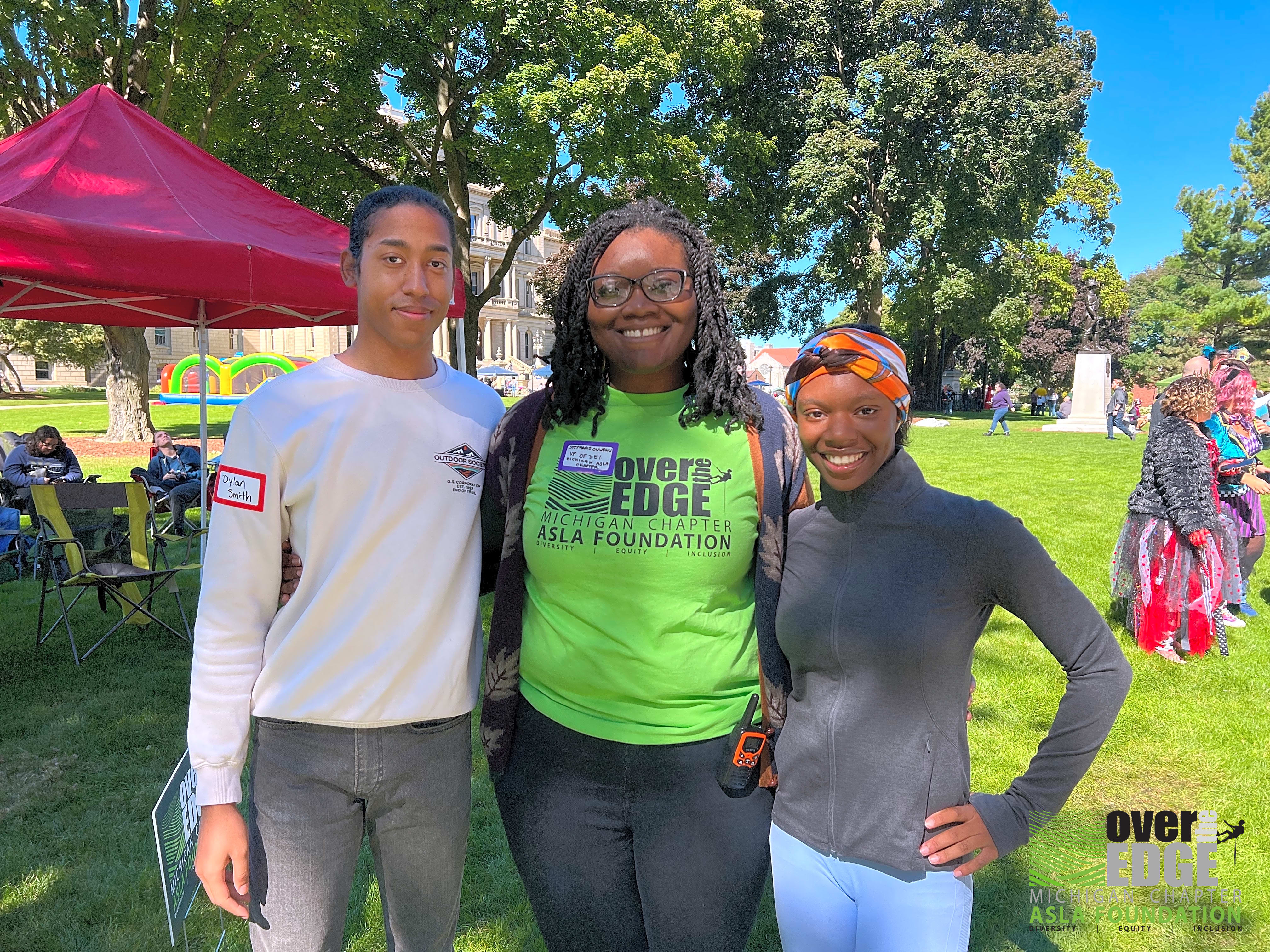Perspectives: Stephanie Onwenu

Stephanie Onwenu is a visual artist, landscape designer, and founder of Ijeomalandartscapes.
April 2024
Tell us about yourself.
I’m a visual artist and landscape designer based in Detroit, where I was born and raised. I have a bachelor’s degree in landscape architecture and a master’s in environmental design, both from Michigan State University. I describe myself as a multifaceted creative and explorer. I’m a people person, a community connector. A lot of what I do in my work is mission driven and based on my passions. I love art, creativity, being outdoors, traveling, coffee, and plants.
What drew you to landscape architecture?
Originally, when I went off to college, my major was civil engineering. I enjoyed the challenge of my math and science courses, but I didn’t find it interesting and started looking for ways to return to the visual arts, which was my focus in high school. In my sophomore year at Michigan State University, I went to the annual student organization fair and came across the ASLA Student Club booth. One of the landscape architecture students showed me a couple of student projects and told me about the classes she was taking. Later that evening, I made the decision to change my major from civil engineering to landscape architecture. For me, it’s that blend of art, science, design, and research. In my practice, I co-design public landscapes as hubs for healing, as spaces for community gathering and activation to celebrate inclusivity of identities and cultures. For example, I’ve recently begun exploring books and topics on neuro-inclusivity in design.
How does your lived experience and identity inform and shape your work?
I grew up as the second of four children to Nigerian parents who each traveled to America in search of better life opportunities. My parents both found themselves in Detroit, met, dated, married, and settled on the west side with two boys and two girls later, plus an older brother. As a family, we worked as a team in home life. We served the community, shared resources, and practiced resiliency amongst cultural differences, living in a home away from home for my parents. My culture has influenced my lived experiences and how I identify myself today.
I saw the work it took to build a small but mighty community while running our family-owned boutique business in Detroit. I’ve been working and helping there since I was around seven. Making direct connections with the residents, listening to the needs of the customers, and providing quality services were values that I learned while helping my family. I have seen my parents push through adversities and challenges to maintain a small business and to support our family needs. I recognized the connections that were being made around me — the resiliency, impacts, and the importance of community support.
As a Nigerian American woman, I honor my lived experiences and the experiences of those who have come before me. My practice explores work areas including but not limited to design justice, culture, collaboration, art, environmental education, and community design. Ijeomalandartscapes is my art practice, which explores the intersections between art, design, history, and culture. Through storytelling, I bring my culture and history into the work that I do. I recently came across a quote from James Baldwin: “History is not the past. It is the present. We carry our history with us. We are our history.”
What are some of the ways you engage with communities as a landscape architect and artist?
I’m a landscape designer and a teaching resident artist at ProjectArt. I teach youth ages 4 to 14 about art, and I trickle a little bit of landscape architecture education in the curriculum, showing them techniques to design their spaces here in Detroit and think about design in a more artistic and creative way. I practice a non-traditional track in the profession of landscape architecture through art and research. I like to offer that as a way for youth and adults to see that they can be creative, and that they can be artistic. I found the profession of landscape architecture in my second year of college, but I want to reach those who are much younger and still trying to figure themselves out. Maybe it will lead to a couple of future landscape architects, landscape designers, or landscape artists.

Can you talk more about taking on a non-traditional track in landscape architecture?
Landscape architects can work in many different fields. After schooling, one doesn't necessarily have to stay on a proper traditional track. I knew early on in college I would somehow make my way back to use my knowledge and skills to help participate at the local level. The diverse areas of focus available to landscape architects are what drew me to designing public spaces in my neighborhood. One could work in a planning department or run for office or serve on a design committee or sit on boards – whether it be locally close to home or at the professional level. I encourage others to get involved in their local community and to continue spreading knowledge of who you are and what you do.
How do you think landscape architects can help make the world a better place and increase their impact?
Landscape architects and designers have the capability to create and design beautiful outdoor spaces that better serve our communities. We have the potential to lead discussions on social and environmental issues as activists in our global society. The collective profession has the capacity to practice our activism in many ways by increasing our impact in how we work, co-create together, and build towards a culture reflective of the work that we do. In this time, the profession has the access and platform to open conversations on the generational gap in perspectives on mental health as design professionals. I believe landscape architects have the access to increase their impact by expanding their networks to grow generational mentorship opportunities for our current and future designers.
Can you say more about what it means to work with communities?
I recently attended the LABash 2024 Conference hosted by the landscape architecture students at the University of California, Davis. During the keynote presentation, “Designing Conscious Spaces,” Kimberly Garza noted “designers as instigators, designers as storytellers, and designers as facilitators”. We must acknowledge the roles that we play as designers engaging directly with communities as facilitators to guide the process. As landscape architects and designers, we must use our skills and knowledge to educate and inform design decisions while following the community's lead.
LAF's Perspectives interview series showcases landscape architects from diverse backgrounds and identities discussing how they came to the profession and where they see it heading. Any opinions expressed in this interview belong solely to the author. Their inclusion in this article does not reflect endorsement by LAF. This interview has been edited for length and clarity.
To stay up-to-date on future Perspectives articles as well as LAF programs, events, and funding opportunities, subscribe to LAF emails.











